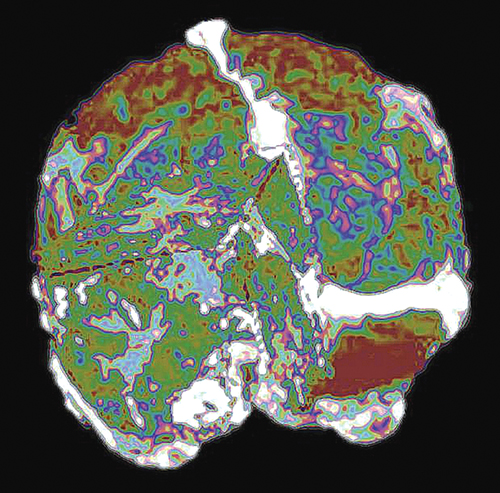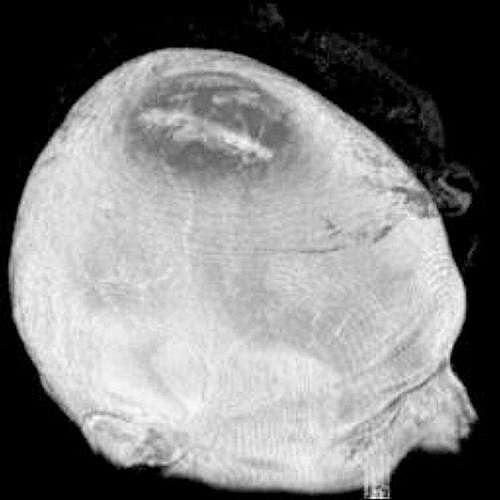
Hierarchical Segmentation Enhances Diagnostic Imaging
Originating Technology/NASA Contribution
Developed by Dr. James Tilton, a computer engineer with Goddard Space Flight Center’s Computational and Information Sciences and Technology Office, Hierarchical Segmentation (HSEG) software allows for advanced image analysis. The software organizes an image’s pixels into regions based on their spectral similarity, so rather than focusing on individual pixels, HSEG focuses on image regions—and how they change from a coarse-to-fine perspective. These regions (segmentations) are at several levels of detail (hierarchies) in which the coarser segmentations can be produced from the finer-resolution segmentations by selective merging of regions. In addition, the segmentation hierarchies provide analysis clues through the behavior of the image region characteristics over several levels of segmentation detail. Thus, by enabling region-based analysis, the segmentation hierarchies organize image data in a manner that makes an image’s information content more accessible.
Within NASA, HSEG was used to identify and extract magnetospheric radio-echo and natural plasma-wave signals captured by the Radio Plasma Imager aboard the Imager for Magnetopause-to-Aurora Global Exploration (IMAGE) spacecraft, which was launched in March 2000, and after completing its 2-year primary mission, was lost in space after a full 5.8 years of exploration.
To advance the usability of the HSEG, Tilton also developed Recursive Hierarchical Segmenting (RHSEG) Pre-processing Software, which significantly improves the extraction of patterns from complex data sets. Optimized for speed and accuracy, the patent-pending algorithm that fuels the software provides the user with precise control for selecting the desired level of detail from the hierarchy of results. The software allows the user to group non-spatially adjacent regions for flexibility with a wide range of image and data types, providing accurate graphic representation of imagery data with minimal distortion and a fine resolution of detail.
Although originally developed for NASA’s remote-sensing applications, HSEG has proven its value in other realms as well. Also originally designed for remote Earth sensing, the RHSEG Pre-processing Software is broadly applicable for a variety of uses, from medical imaging to data mining, and it is now capable of three-dimensional (3-D) data analysis, a capability NASA is in the process of patenting.
Partnership
Bartron Medical Imaging LLC (BMI), of New Haven, Connecticut, gained a nonexclusive license from Goddard Space Flight Center to use the RHSEG software in medical imaging.
In order to manage the image data, BMI also licensed two pattern-matching software programs from NASA’s Jet Propulsion Laboratory that were used in image analysis and three data-mining and edge-detection programs from Kennedy Space Center. The Kennedy imaging technologies are currently in use at NASA to identify and track foreign object debris during space shuttle liftoff, and in the Cable and Line Inspection Mechanism used to test the shuttle’s emergency escape system.
In addition, BMI made NASA history by being the first company to partner with the Space Agency through a Cooperative Research and Development Agreement (CRADA). This agreement, for development of the 3-D version of RHSEG, grants (in advance) a partially exclusive license for the resulting technology patents within BMI’s fields of use (i.e., the diagnosis and treatment of breast cancer, cervical cancer, brain cancer, heart disease, osteoporosis, and periodontal diseases).
Product Outcome
With U.S. Food and Drug Administration clearance, BMI will sell its Med-Seg imaging system with the 2-D version of the RHSEG software, licensed from NASA in 2002 and featured in Spinoff 2004. The device is intended to analyze medical imagery from computed tomography (CT or CAT) scans, positron emission tomography (PET) scans, magnetic resonance imaging (MRI), ultrasound, digitized X-rays, digitized mammographies, dental X-rays, soft tissue analyses, and moving object analyses; the technology is also equipped to evaluate soft-tissue slides such as Pap smears for the diagnoses and management of diseases. The advanced image segmentations produced by the RHSEG software allow the Med-Seg system to bring out details in these tests not previously seen with the naked eye. This allows for quick and accurate diagnosis of diseases. Additionally, unlike some other image-analysis devices, Med-Seg does not manipulate the image, so what the physician sees is truly what is there, providing truer images than many other imaging techniques.
The Med-Seg system reveals image properties not seen with even up-to-date image enhancement techniques. It is available with a custom data-mining server; a computational engine; and an object-oriented database to manage data, models, and results, and access BMI’s Hierarchical Image Segmentation Beowulf Cluster, an online problem-solving network.
By extending the software’s capabilities to three dimensions, BMI’s device may be able to produce a pixel-level view of all sides of a tumor or lesion. While current technology can produce 3-D imagery, the RHSEG software will be able to segment an image in ways that more clearly define problem areas. For example, the 3-D version of Med-Seg may be able to identify very early buildup of soft plaque within the arteries or identify density levels of microcalcification in mammographies, allowing physicians to diagnose malignant breast tumors well before they would normally be seen. In brain images, the physicians using Med-Seg will also be able to make earlier diagnoses of tumors or arteriovenous malformations.

The RHSEG software presents its results in a straightforward format consisting of a hierarchical set of image segmentations in either two or three spatial dimensions. This hierarchical presentation of results allows the user to choose the segmentation(s) of interest and to perform additional analyses.


Rather than working on the usual pixel-by-pixel basis, the RHSEG automatically organizes pixels into regions hierarchically, based on their spectral similarity. Looking at these regions, as opposed to individual pixels, allows the user to isolate specific features that are impossible to distinguish by other methods. Thus, the RHSEG provides a more reliable and accurate understanding of the image.













